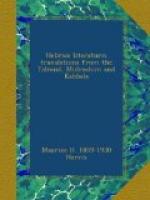This prayer is to be performed standing, and the feet so joined together that they should seem as it were one foot only, in order to be like the angels, of whom it is written (Ezek. i. 7), “And their feet were (so in the original) a straight foot,” that is to say, their feet appeared as one foot.
This attitude is a sign that the power of locomotion is gone; he cannot pursue and attain any other object than God. The Gentiles place their hands together, intending to signify thereby that their hands are as it were bound; but we, by placing our feet together, intend to signify that they are as it were entirely bound, which is indicative of greater humility; for with the hands bound one could still run away in search of his own pleasure, which he cannot do when the feet are bound.
Kitzur Sh’lh, fol. 48, col. 2, and fol. 49, col. 1.
It is lawful for him who rides upon an animal to pray the eighteen benedictions, and when he comes to the point when he should retrace three steps, he is to back the animal he is mounted on three steps. And so also it is lawful to pray the eighteen blessings when sitting and traveling in a wagon.
Ibid., fol. 49, col. 1.
It is necessary to pay attention to the feet when the worshiper repeats “Holy! holy! holy!” and he is to lift up his eyes toward heaven. At the instant the Kiddushah is repeated he needs only lift up his heels, and thereby his body from the earth toward heaven.... According to Tanchuma it is necessary to lift up the feet from the earth altogether, after the example of the angels, of whom it is written (Isa. vi. 2), “And with two he did fly.” It is from this text that the sages have ordained that a man should fly up (as it were) when he repeats “Holy! holy! holy!” And let the chooser choose, i.e. it is optional either to lift up the heels only or to jump.
Ibid.
Any one who visits a synagogue
may notice the observance of this
practice. In the synagogues
of the Chassidim, jumping is
preferred to lifting up the
heels.
It is written (Ps. cii. 17), “He will regard the prayer of the destitute,” and it is not written, “He will hear.” What else can the term “regard” mean than that there is a distinction between the prayer of an individual and the prayer of a community? For when a community prays, their prayer enters before the Holy One—blessed be He!—and He is not particular to regard and criticise their works and their intentions and thoughts, but receives their prayers immediately. But when an individual prays, the Holy One—blessed be He!—regards and scrutinizes his heart, whether it be devout and whether he be a righteous man. Therefore, one should always pray with the community, and this is why the text (Ps. cvii. 17) ends with the words, “And not despise their prayer.” Although there are some of the community whose prayers, on account of their evil deeds, deserve to be despised, He, nevertheless, does not despise their prayer.




